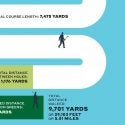GOLF’s Top 100 course panelists are among the most respected and well-traveled course evaluators in the game. They’re also keen to share their opinions. In this new GOLF.com series, we’ll be granting them anonymity and turning to them for their unvarnished views on all questions course-related. The goal is not only to entertain you but also to give you a better understanding of how GOLF’s panelists assess courses. We’ve asked our experts to discuss Augusta National’s secrets, the difficulty of the course, its standing among the best in the world, and more.
Meet our panel:
Panelist 1: Panelist since 2014. Has played 65 of the World Top 100
Panelist 2: Has played 70 of current World Top 100
Panelist 3: Panelist since 2015; has played 72 of the current list
Panelist 4: Since 2012; has played 82 of the current list
Panelist 5: Since 2015; has played all 100 of the current list
Panelist 6: Has played 45 of the World Top 100

1. Let’s set aside the tournament and the other prestigious trappings and assess Augusta National on design alone. It ranks No. 5 on GOLF Magazine’s list of Top 100 Courses. Is that too high? Too low? Just right? Why?
Panelist 1: Probably fair to be in the top 10, but I would say more like eighth or ninth in the world. Mainly because of the stretch of holes 10-16 and the incredible agronomic excellence they achieve every year.
Panelist 2: I’d have it in my top five. It is hard to be able to separate “only the course” from tournament memories. Certainly one of my top two “overall experiences, playing/staying on site overnight.” The aura of everything there is just out of this world. But the course itself has so many challenges and required strategy from start to end that I think it deserves its high ranking.
Panelist 3: A little too high, based on the number of decidedly average holes among the iconic holes. If you want a comparison point, I see Pebble Beach through the exact same lens.
Panelist 4: Hard to separate the incredible experience from the course. There are so many outstanding holes that the few that are pedestrian (3, 5, 8, 17) provide an appropriate balance. Answering this “confidential” question as a GOLF magazine panelist creates great angst in that if one’s answer was known by any member, the individual expressing such would likely be permanently blackballed from playing there again as Augusta views itself, perhaps correctly, as the supreme deity of golf. Adding the Women’s Amateur probably makes it the No. 1 course golfers would like to play, which begs the question: is the experience in the top five? Without question. Is the course in the top five from the first tee to the 18th green? Perhaps not.
Panelist 5: It is about right. There’s a wonderful variety of holes, in both distance and shot value, and a compelling collection of reachable par-fives with high risk-reward. The greens are so fast and pure you have to trust your caddie completely and thank him profusely for every two-putt.
Panelist 6: I believe its ranking is a bit high, but it’s certainly in the top 10. Aside from the greens speeds and awkward lies, the golf course from a difficulty standpoint is quite fair and benign.
2. What surprised you most about the course the first time you played it?
Panelist 1: The slopes on the greens, which are not really visible on TV coverage.
Panelist 2: The elevation changes, particularly on 8, 9, 10, 11, and 18.
Panelist 3: The complexity of the 1st, 3rd, 4th, 5th, 14th and 17th greens for reading putts. The 17th in particular, where the land around it is so strong that it hides the fall in the green surface. It’s those eccentricities that you just can’t see from the gallery or television. I was even more impressed with the greens in person. I think the 4th might be the wildest of all.
Panelist 4: The elevation changes and the slope on the greens, especially at 6, 7 and the front portion of 14.
Panelist 5: The course is not long from the members’ tees. One would not appreciate the elevation changes on some of the holes on TV. You have to be at the course to feel the severe downhill of the 10th hole and the steepness of the uphill on 18.
Panelist 6: Green speeds and elevation changes.
3. In your visit(s), what has been your most memorable ‘this could only happen at Augusta’ moment?
Panelist 1: Played the back tees and on the first hole I asked the starter if the box by the members tee was a ball washer. He said, “No Sir, we don’t have ball washers at Augusta National. If someone is going to bring out an old dirty ball to play Augusta, probably should not be playing here.”
Panelist 2: There were several. Staying overnight in a cabin was special. Getting to see (and have a drink in) the Crow’s Nest. Visiting the renowned wine cellar in the bottom of the clubhouse, which I’m sure rivals any wine cellar anywhere for quality. I think the wine list was over 30 pages! Last but certainly not least: slipping on a member’s green jacket, but only in our cottage. And no pictures of me doing so!
Panelist 3: The staff sang to our group numerous Southern melodies during cocktail hour.
Panelist 4: After the round, being taken into the Champions locker room and being introduced to Mark O’Meara, who happened to be there at the time. Being allowed in the locker room was a thrill.
Panelist 5: Stayed overnight in a cabin. And walked into the dining room and seeing each table has a member wearing the green jacket. You know who are the members and who are the guests!
Panelist 6: Cabin stays, wine cellar visit, back-to-back birdies at 18 on consecutive days.

4. What’s the single hardest or most intimidating shot?
Panelist 1: Tee shot on 18 and any putt on the sixth green.
Panelist 2: The tee shot on the first hole to start your round. You’re finally there and you want to play well. But you particularly don’t want to hit a poor first tee shot, potentially with others looking on. Butterflies in your stomach feel like condors.
Panelist 3: I think the single hardest shot for regular golfers (not the pros) is going for the green in two on 15. Downhill lie, need to carry the water but stop it on the green. Usually better to lay up and try to hit a nice wedge in.
Panelist 4: Tee shot on 12 followed by the second to 13 (if you are going for it), the second shot to 15 (if you are going for it) and the shot into 18, only because they are usually pivotal holes during the Masters when you get to ask yourself, “How good am I?”
Panelist 5: The approach to a front-left pin on the third hole uphill to a green falling away. I’m not even sure how it’s possible, but we have seen it done!
Panelist 6: The current length is perfect for members and mid-to-high handicappers. It will be great when they lengthen it for tournament play.
5. Should the 13th hole be lengthened? Why or why not?
Panelist 1: I don’t think so. It is such a great hole because it is reachable and provides great drama during the tournament. If lengthened, it would most likely become an average three shot par-5.
Panelist 2: No. The risk/reward there is one of the most intriguing on the course. And the angles make all the difference in your decision on what to hit.
Panelist 3: The current length is fine. I prefer the drama of having most still try for the green.
Panelist 4: Perhaps a wee bit. It seems a lot of players hit it into the pine straw. One really has to shape the shot to be in the fairway.
Panelist 5: No. Keep it reachable for the long hitters, but with high risk for the second shot.
Panelist 6: The length is perfect currently for the members and mid-to-high handicappers. It will be great when lengthened for the tournament.

6. Congratulations, you’ve been appointed chairperson of Augusta National. What’s the first design change you plan to make?
Panelist 1: Tough decision, but I would probably try to improve 17 and 18. They are not bad holes, but as finishing holes they seem to have less character and quality than the previous seven on the back nine.
Panelist 2: I likely wouldn’t mess with anything. It is so good right now. But as I go back in my head and think about each hole, No. 5 seems the least memorable (other than absolutely needing to stay out of the huge bunker on the left with your drive), so I’d probably look at that one to see how it might be enhanced. But I wouldn’t hurry to change anything.
Panelist 3: Fire Tom Fazio…sorry was that my outside voice? At some point they need to think a lot more about their history. It doesn’t mean they have to give up the changes, but the work most recently done is far removed from the foundational ideas that made the course special.
Panelist 4: Probably nothing, but I would consider more fairway bunkers to tighten some of the holes and maybe regrade the landing area on 11.
Panelist 5: The course is fine as it is. I am not sure why we feel the need to tweak holes so often.
Panelist 6: You wouldn’t ask Da Vinci to paint a mustache on the Mona Lisa.









